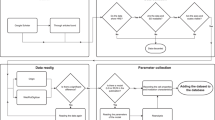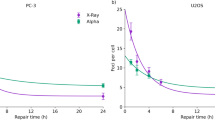Abstract
The term radiation-induced bystander effects describes a situation where cells that have not been directly exposed to ionizing radiation behave as though they have been exposed: they die or they show chromosomal instability and other abnormalities. The bystander cells might be immediately adjacent or might be some distance away from the exposed cell. Although the nature of the communication system that is involved in producing these responses is not yet known, there is strong evidence for a chemical signalling process that transmits information from the irradiated cell to neighbouring cells. The bystander effect has several important implications for radiation protection, radiotherapy and diagnostic radiology.
This is a preview of subscription content, access via your institution
Access options
Subscribe to this journal
Receive 12 print issues and online access
$209.00 per year
only $17.42 per issue
Buy this article
- Purchase on Springer Link
- Instant access to full article PDF
Prices may be subject to local taxes which are calculated during checkout



Similar content being viewed by others
References
Nagasawa, H. & Little, J. B. Induction of sister chromatid exchanges by extremely low doses of α-particles. Cancer Res. 52, 6394–6396 (1992).
Deshpande, A., Goodwin, E. H., Bailey, S. M., Marrone, B. L. & Lehnert, B. E. α-particle-induced sister chromatid exchange in normal human lung fibroblasts: evidence for an extranuclear target. Radiat Res. 145, 260–267 (1996).
Mothersill, C. & Seymour, C. B. Medium from irradiated human epithelial cells but not human fibroblasts reduces the clonogenic survival of unirradiated cells. Int. J. Radiat. Biol. 71, 421–427 (1997).
Sawant, S. G. Randers-Pehrson, G., Geard, C. R., Brenner, D. J. & Hall, E. J. The bystander effect in radiation oncogenesis: I. Transformation in C3H 10T1/2 cells in vitro can be initiated in the unirradiated neighbors of irradiated cells. Radiat Res. 155, 397–401 (2001).
Zhou, H. et al. Induction of a bystander mutagenic effect of α-particles in mammalian cells. Proc. Natl Acad. Sci. USA 97, 2099–2104 (2000).
Nagasawa, H. & Little, J. B. Bystander effect for chromosomal aberrations induced in wild-type and repair deficient CHO cells by low fluences of α particles. Mutat Res. 508, 121–129 (2002).
Seymour, C. B. & Mothersill, C. Delayed expression of lethal mutations and genomic instability in the progeny of human epithelial cells that survived in a bystander-killing environment. Radiat. Oncol. Investig. 5, 106–110 (1997).
Lorimore, S. A. et al. Chromosomal instability in the descendants of unirradiated surviving cells after α-particle irradiation. Proc. Natl Acad. Sci. USA 95, 5730–5733 (1998).
Huo, L., Nagasawa, H. & Little, J. B. HPRT mutants induced in bystander cells by very low fluences of α particles result primarily from point mutations. Radiat Res. 156, 521–525 (2001).
Parsons, W. B., Watkins, C. H., Pease, G. L. & Childs, D. S. Changes in sternal bone marrow following rontegan-ray therapy to the spleen in chronic granulocytic leukaemia. Cancer 7, 179–189 (1954).
Goh, K. & Sumner, H. Breaks in normal human chromosomes: are they induced by a transferable substance in the plasma of persons exposed to total body irradiation? Radiat. Res. 35, 171–181 (1968).
Hollowell, J. G. & Littlefield, L. G. Chromosome damage induced by plasma of X-rayed patient: an indirect effect of radiation. Proc. Soc. Exp. Biol. Med. 129, 240–244 (1968).
Lyng, F. M., Seymour, C. B. & Mothersill, C. Production of a signal by irradiated cells which leads to a response in unirradiated cells characteristic of apoptosis. Brit. J. Cancer 83, 1223–1230 (2000).
Lyng, F. M., Seymour, C. B. & Mothersill, C. Initiation of apoptosis in cells exposed to medium from the progeny of irradiated cells: a possible mechanism for 'bystander' induced instability? Radiat. Res. 157, 365–370 (2002).
Mothersill, C. & Seymour, C. B. Radiation-induced bystander effects: past history and future perspectives. Radiat. Res. 155, 759–767 (2001).
Goldberg, Z. & Lehnert, B. E. Radiation-induced effects in unirradiated cells: a review and implications in cancer. Int. J. Oncol. 21, 337–349 (2002).
Prise, K. M. et al. Investigating the cellular effects of isolated radiation tracks using microbeam techniques. Adv. Space Res. 30, 871–876 (2002).
Mothersill, C. & Seymour, C. B. Cell–cell contact during γ-irradiation is not required to induce a bystander effect in normal human keratinocytes: Evidence for release of a survival controlling signal into medium. Radiat. Res. 149, 256–262 (1998).
Nagar, S., Smith, L. E. & Morgan, W. F. Characterization of a novel epigenetic effect of ionizing radiation: the death-inducing effect. Cancer Res. 63, 324–328 (2003).
Mothersill, C. et al. Individual variation in the production of a 'bystander signal' following irradiation of primary cultures of normal human urothelium. Carcinogenesis 22, 1465–1471 (2001).
Watson, G. E., Lorimore, S. A., MacDonald, D. A. & Wright, E. G. Chromosomal instability in unirradiated cells induced in vivo by a bystander effect of ionising radiation. Cancer Res. 60, 5608–5611 (2000).
Bridges, B. A. Radiation and germline mutation at repeat sequences: are we in the middle of a paradigm shift? Radiat Res. 156, 631–641 (2001).
Denekamp, J. & Dasu, A. Inducible repair and the two forms of tumour hypoxia: time for a paradigm shift. Acta Oncol. 38, 903–918 (1999).
Elkind, M. M. Cell-cycle sensitivity, recovery from radiation damage and a new paradigm for risk assessment. Int. J. Radiat. Biol. 71, 657–665 (1997).
Little, J. B., Nagasawa, H., Li, G. C. & Chen, D. J. Involvement of the nonhomologous end joining DNA repair pathway in the bystander effect for chromosomal aberrations. Radiat Res. 159, 262–267 (2003).
Mothersill, C., Seymour, R. J. & Seymour, C. B. Radiation-induced bystander effects in repair deficient cell lines. Radiat. Res. (in the press).
Azzam, E. I., De Toledo, S. M., Spitz, D. R. & Little, J. B. Oxidative metabolism modulates signal transduction and micronucleus formation in bystander cells from α-particle-irradiated normal human fibroblast cultures. Cancer Res. 62, 5436–5442 (2002).
Magor, B. G., De Tomaso, A., Rinkevich, B. & Weissman, I. L. Allorecognition in colonial tunicates: protection against predatory cell lineages? Immunol Rev. 167, 69–79 (1999).
Ogmundsdottir, H. M., Zoega, G. M., Gissurarson, S. R. & Ingolfsdottir, K. Anti-proliferative effects of lichen-derived inhibitors of 5-lipoxygenase on malignant cell lines and mitogen-stimulated lymphocytes. J. Pharm. Pharmacol. 50, 107–115 (1998).
Wiens, M., Krasko, A., Perovic, S. & Muller, W. E. Caspase-mediated apoptosis in sponges: cloning and function of the phylogenetic oldest apoptotic proteases from Metazoa. Biochim. Biophys. Acta 1593, 179–189 (2003).
Rothkamm, K. & Lobrich, M. Evidence for a lack of DNA double-strand break repair in human cells exposed to very low x-ray doses. Proc. Natl Acad. Sci. USA 100, 5057–5062 (2003).
Wolff, S. Adaptation to ionizing radiation induced by prior exposure to very low doses. Chin. Med. J. 107, 425–430 (1994).
Mothersill, C. & Seymour, C. B. Bystander and delayed effects after fractionated radiation exposure. Radiat. Res. 158, 626–633 (2002)
Sinclair, W. K. The linear no-threshold response: why not linearity? Med Phys. 25, 285–290 (1998).
Clutton, S. M., Townsend, K. M. S, Walker, C., Ansell, J. D. & Wright, E. G. Radiation-induced genomic instability and persistent oxidative stress in primary bone marrow cultures. Carcinogenesis 17, 1633–1639 (1996).
Limoli, C. L. et al. Apoptosis, reproductive failure, and oxidative stress in Chinese hamster ovary cells with compromised genomic integrity. Cancer Res. 58, 3712–3718 (1998).
Mothersill, C. et al. Involvement of energy metabolism in the production of 'bystander effects' by radiation. Br. J. Cancer 82, 1740–1746 (2000).
Iyer, R., Lehnert, B. E. & Svensson, R. Factors underlying the cell growth-related bystander responses to α particles. Cancer Res. 60, 1290–1298 (2000).
Lyng, F. M., Seymour, C. B. & Mothersill, C. Early events in the apoptotic cascade initiated in cells treated with medium from the progeny of irradiated cells. Radiat. Prot. Dosimetry 99, 169–172 (2002).
Acknowledgements
The authors acknowledge support from the following sources in Ireland and Europe: the Science Foundation Ireland; Saint Luke's Institute of Cancer Research; the Cancer Research Advancement Board; and the European Union Radiation Protection Programme.
Author information
Authors and Affiliations
Corresponding author
Ethics declarations
Competing interests
The authors declare no competing financial interests.
Related links
Rights and permissions
About this article
Cite this article
Seymour, C., Mothersill, C. Radiation-induced bystander effects — implications for cancer. Nat Rev Cancer 4, 158–164 (2004). https://doi.org/10.1038/nrc1277
Issue Date:
DOI: https://doi.org/10.1038/nrc1277
This article is cited by
-
Need of Quantum Biology to Investigate Beneficial Effects at Low Doses (< 100 mSv) and Maximize Peaceful Applications of Nuclear Energy
MAPAN (2023)
-
Radiobiological effects of wound fluid on breast cancer cell lines and human-derived tumor spheroids in 2D and microfluidic culture
Scientific Reports (2022)
-
Bystander effects induced by the interaction between urothelial cancer cells and irradiated adipose tissue-derived stromal cells in urothelial carcinoma
Human Cell (2022)
-
Extracellular vesicles: mediators of intercellular communication in tissue injury and disease
Cell Communication and Signaling (2021)
-
Quantitative modeling of multigenerational effects of chronic ionizing radiation using targeted and nontargeted effects
Scientific Reports (2021)



